Human Resource Management and Employee Well-being at Marriott Hotels
VerifiedAdded on 2020/10/20
|12
|3706
|35
Report
AI Summary
This report examines Marriott Hotels' approach to employee well-being management within the hospitality industry. It explores key aspects of their human resource management (HRM) strategies, including manpower planning, recruitment and selection, training and development, and employee retention initiatives. The report highlights Marriott's commitment to employee recognition through awards, job rotation practices, and a supportive work environment. It analyzes the impact of these strategies on employee engagement, job satisfaction, and organizational commitment. Furthermore, it delves into the company's training programs, such as the initial training sessions and the implementation of the DMAIC roadmap and Lean Sigma methodology by Marriott Business Services (MBS). The report also addresses the challenges associated with managing employee well-being, emphasizing the importance of continuous improvement and the need to adapt to the fast-moving industry. The report concludes by emphasizing the importance of human resource management in driving overall performance and the significance of employee well-being for the company's success.
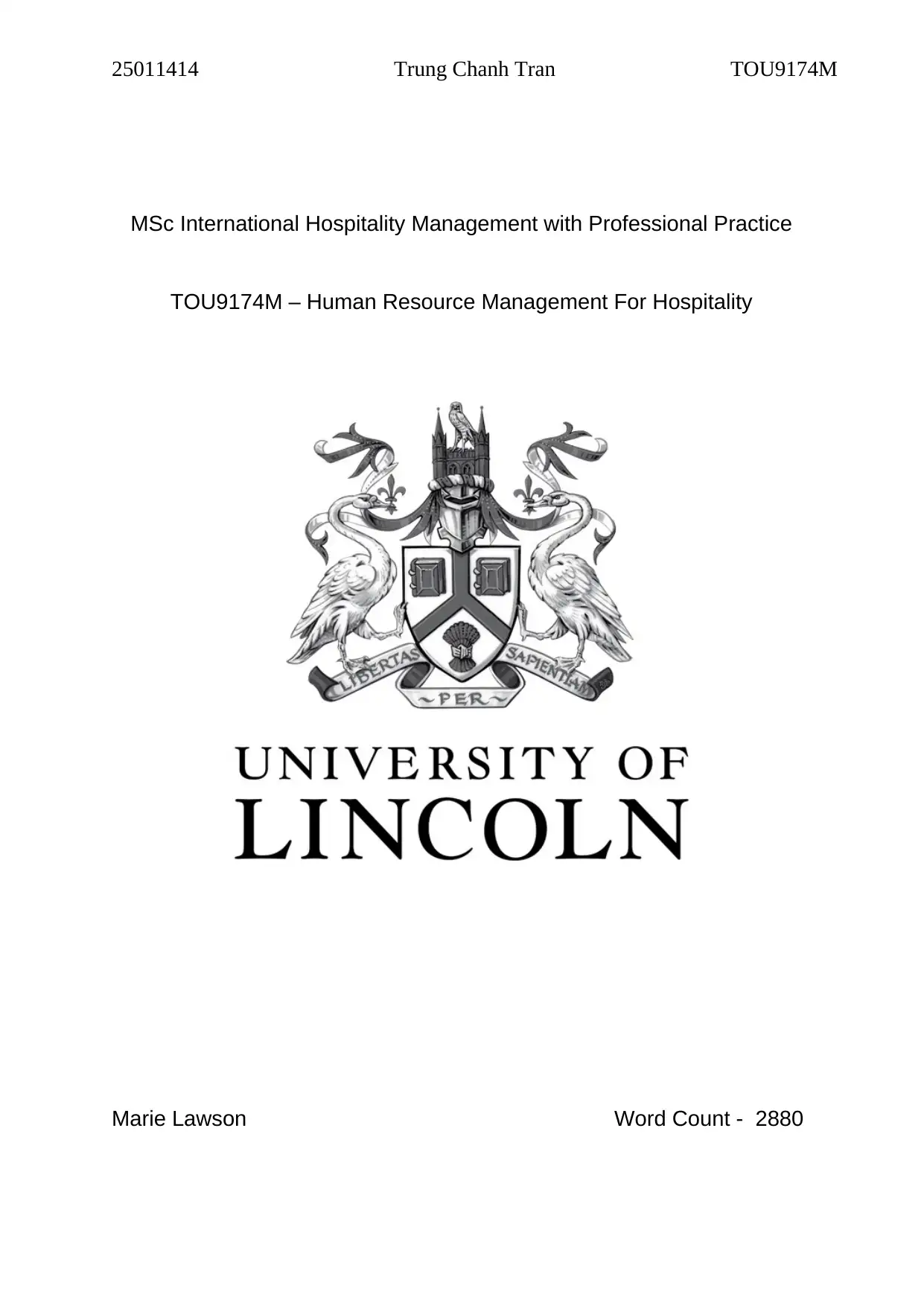
25011414 Trung Chanh Tran TOU9174M
MSc International Hospitality Management with Professional Practice
TOU9174M – Human Resource Management For Hospitality
Marie Lawson Word Count - 2880
MSc International Hospitality Management with Professional Practice
TOU9174M – Human Resource Management For Hospitality
Marie Lawson Word Count - 2880
Paraphrase This Document
Need a fresh take? Get an instant paraphrase of this document with our AI Paraphraser
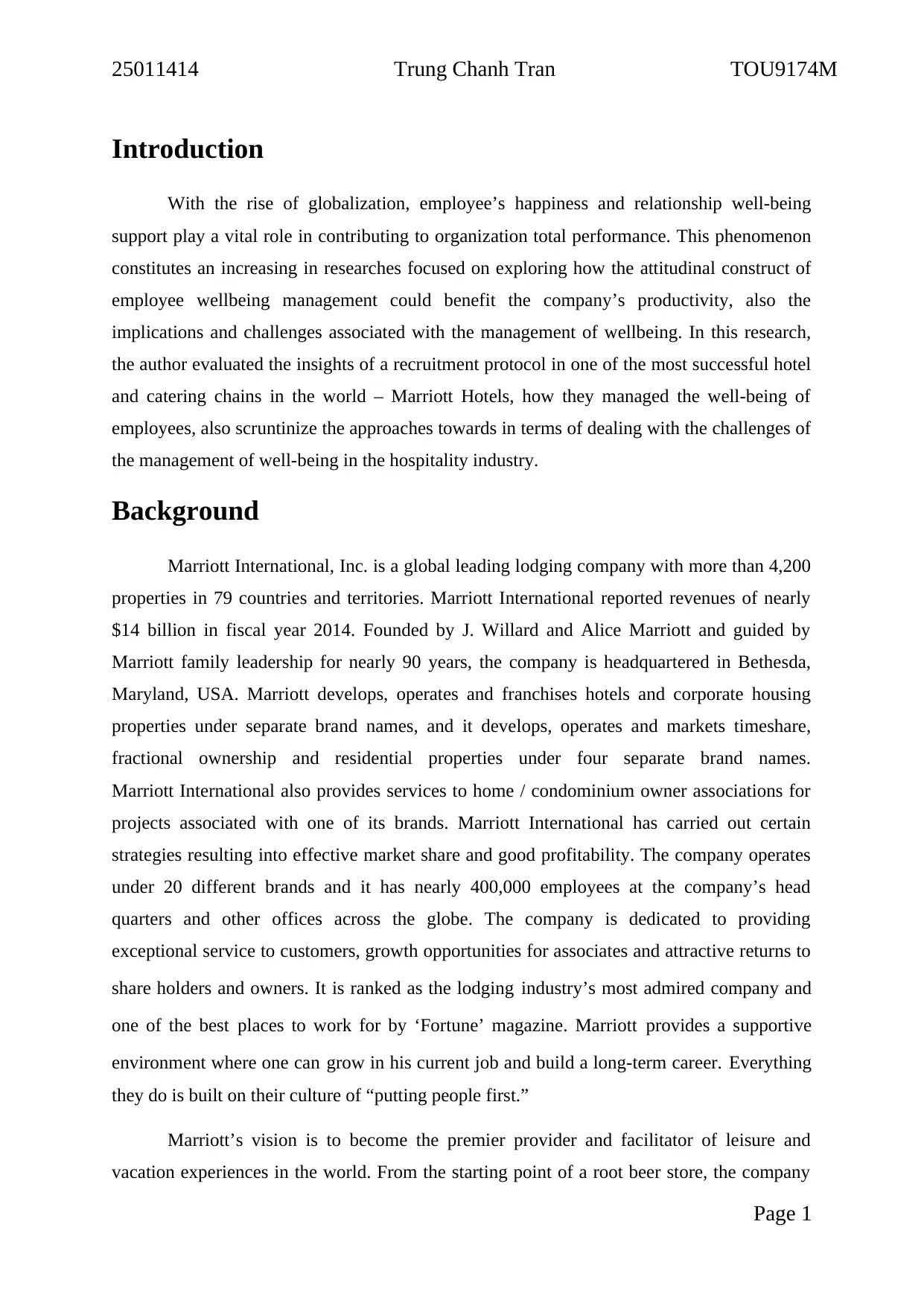
25011414 Trung Chanh Tran TOU9174M
Introduction
With the rise of globalization, employee’s happiness and relationship well-being
support play a vital role in contributing to organization total performance. This phenomenon
constitutes an increasing in researches focused on exploring how the attitudinal construct of
employee wellbeing management could benefit the company’s productivity, also the
implications and challenges associated with the management of wellbeing. In this research,
the author evaluated the insights of a recruitment protocol in one of the most successful hotel
and catering chains in the world – Marriott Hotels, how they managed the well-being of
employees, also scruntinize the approaches towards in terms of dealing with the challenges of
the management of well-being in the hospitality industry.
Background
Marriott International, Inc. is a global leading lodging company with more than 4,200
properties in 79 countries and territories. Marriott International reported revenues of nearly
$14 billion in fiscal year 2014. Founded by J. Willard and Alice Marriott and guided by
Marriott family leadership for nearly 90 years, the company is headquartered in Bethesda,
Maryland, USA. Marriott develops, operates and franchises hotels and corporate housing
properties under separate brand names, and it develops, operates and markets timeshare,
fractional ownership and residential properties under four separate brand names.
Marriott International also provides services to home / condominium owner associations for
projects associated with one of its brands. Marriott International has carried out certain
strategies resulting into effective market share and good profitability. The company operates
under 20 different brands and it has nearly 400,000 employees at the company’s head
quarters and other offices across the globe. The company is dedicated to providing
exceptional service to customers, growth opportunities for associates and attractive returns to
share holders and owners. It is ranked as the lodging industry’s most admired company and
one of the best places to work for by ‘Fortune’ magazine. Marriott provides a supportive
environment where one can grow in his current job and build a long-term career. Everything
they do is built on their culture of “putting people first.”
Marriott’s vision is to become the premier provider and facilitator of leisure and
vacation experiences in the world. From the starting point of a root beer store, the company
Page 1
Introduction
With the rise of globalization, employee’s happiness and relationship well-being
support play a vital role in contributing to organization total performance. This phenomenon
constitutes an increasing in researches focused on exploring how the attitudinal construct of
employee wellbeing management could benefit the company’s productivity, also the
implications and challenges associated with the management of wellbeing. In this research,
the author evaluated the insights of a recruitment protocol in one of the most successful hotel
and catering chains in the world – Marriott Hotels, how they managed the well-being of
employees, also scruntinize the approaches towards in terms of dealing with the challenges of
the management of well-being in the hospitality industry.
Background
Marriott International, Inc. is a global leading lodging company with more than 4,200
properties in 79 countries and territories. Marriott International reported revenues of nearly
$14 billion in fiscal year 2014. Founded by J. Willard and Alice Marriott and guided by
Marriott family leadership for nearly 90 years, the company is headquartered in Bethesda,
Maryland, USA. Marriott develops, operates and franchises hotels and corporate housing
properties under separate brand names, and it develops, operates and markets timeshare,
fractional ownership and residential properties under four separate brand names.
Marriott International also provides services to home / condominium owner associations for
projects associated with one of its brands. Marriott International has carried out certain
strategies resulting into effective market share and good profitability. The company operates
under 20 different brands and it has nearly 400,000 employees at the company’s head
quarters and other offices across the globe. The company is dedicated to providing
exceptional service to customers, growth opportunities for associates and attractive returns to
share holders and owners. It is ranked as the lodging industry’s most admired company and
one of the best places to work for by ‘Fortune’ magazine. Marriott provides a supportive
environment where one can grow in his current job and build a long-term career. Everything
they do is built on their culture of “putting people first.”
Marriott’s vision is to become the premier provider and facilitator of leisure and
vacation experiences in the world. From the starting point of a root beer store, the company
Page 1
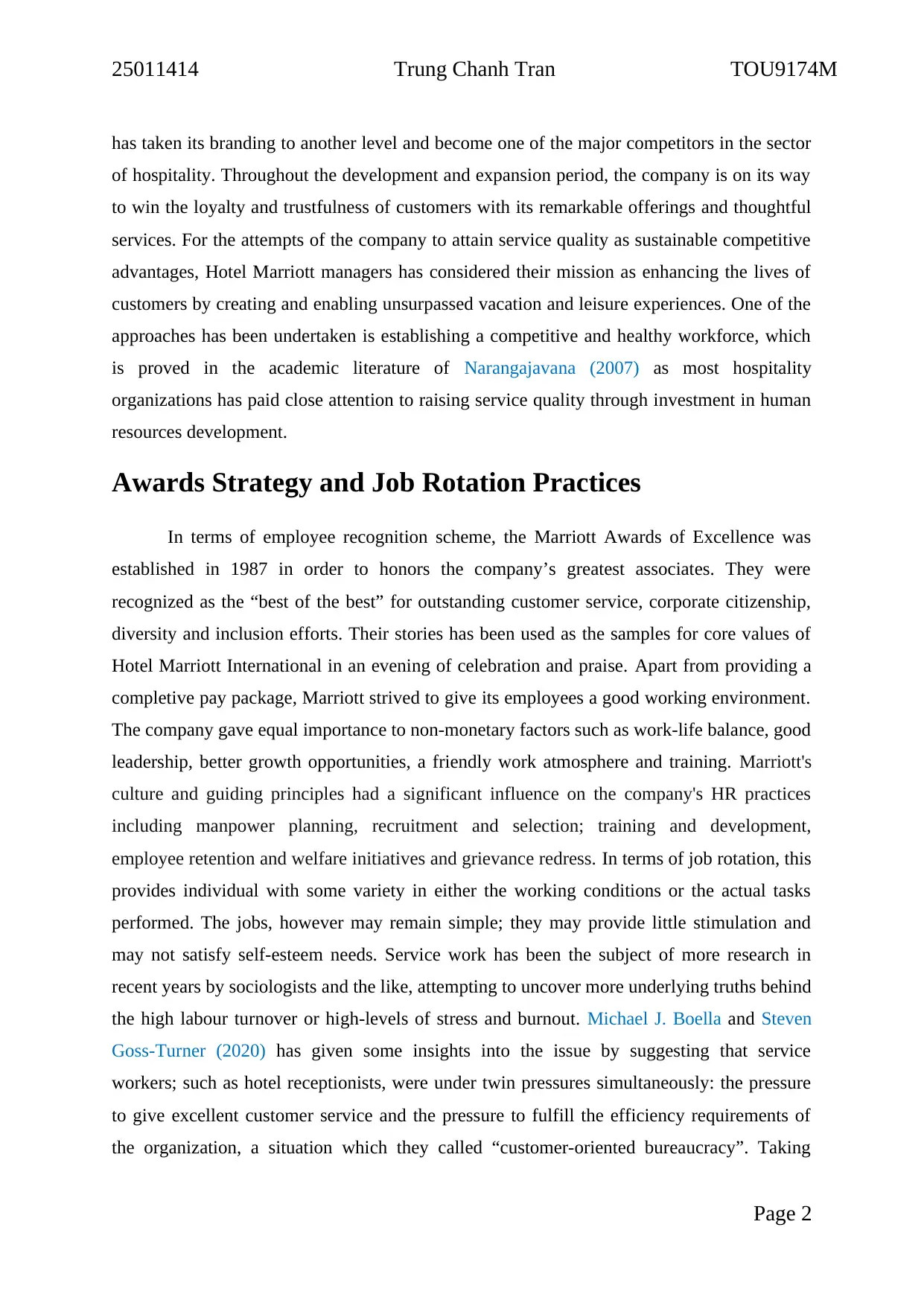
25011414 Trung Chanh Tran TOU9174M
has taken its branding to another level and become one of the major competitors in the sector
of hospitality. Throughout the development and expansion period, the company is on its way
to win the loyalty and trustfulness of customers with its remarkable offerings and thoughtful
services. For the attempts of the company to attain service quality as sustainable competitive
advantages, Hotel Marriott managers has considered their mission as enhancing the lives of
customers by creating and enabling unsurpassed vacation and leisure experiences. One of the
approaches has been undertaken is establishing a competitive and healthy workforce, which
is proved in the academic literature of Narangajavana (2007) as most hospitality
organizations has paid close attention to raising service quality through investment in human
resources development.
Awards Strategy and Job Rotation Practices
In terms of employee recognition scheme, the Marriott Awards of Excellence was
established in 1987 in order to honors the company’s greatest associates. They were
recognized as the “best of the best” for outstanding customer service, corporate citizenship,
diversity and inclusion efforts. Their stories has been used as the samples for core values of
Hotel Marriott International in an evening of celebration and praise. Apart from providing a
completive pay package, Marriott strived to give its employees a good working environment.
The company gave equal importance to non-monetary factors such as work-life balance, good
leadership, better growth opportunities, a friendly work atmosphere and training. Marriott's
culture and guiding principles had a significant influence on the company's HR practices
including manpower planning, recruitment and selection; training and development,
employee retention and welfare initiatives and grievance redress. In terms of job rotation, this
provides individual with some variety in either the working conditions or the actual tasks
performed. The jobs, however may remain simple; they may provide little stimulation and
may not satisfy self-esteem needs. Service work has been the subject of more research in
recent years by sociologists and the like, attempting to uncover more underlying truths behind
the high labour turnover or high-levels of stress and burnout. Michael J. Boella and Steven
Goss-Turner (2020) has given some insights into the issue by suggesting that service
workers; such as hotel receptionists, were under twin pressures simultaneously: the pressure
to give excellent customer service and the pressure to fulfill the efficiency requirements of
the organization, a situation which they called “customer-oriented bureaucracy”. Taking
Page 2
has taken its branding to another level and become one of the major competitors in the sector
of hospitality. Throughout the development and expansion period, the company is on its way
to win the loyalty and trustfulness of customers with its remarkable offerings and thoughtful
services. For the attempts of the company to attain service quality as sustainable competitive
advantages, Hotel Marriott managers has considered their mission as enhancing the lives of
customers by creating and enabling unsurpassed vacation and leisure experiences. One of the
approaches has been undertaken is establishing a competitive and healthy workforce, which
is proved in the academic literature of Narangajavana (2007) as most hospitality
organizations has paid close attention to raising service quality through investment in human
resources development.
Awards Strategy and Job Rotation Practices
In terms of employee recognition scheme, the Marriott Awards of Excellence was
established in 1987 in order to honors the company’s greatest associates. They were
recognized as the “best of the best” for outstanding customer service, corporate citizenship,
diversity and inclusion efforts. Their stories has been used as the samples for core values of
Hotel Marriott International in an evening of celebration and praise. Apart from providing a
completive pay package, Marriott strived to give its employees a good working environment.
The company gave equal importance to non-monetary factors such as work-life balance, good
leadership, better growth opportunities, a friendly work atmosphere and training. Marriott's
culture and guiding principles had a significant influence on the company's HR practices
including manpower planning, recruitment and selection; training and development,
employee retention and welfare initiatives and grievance redress. In terms of job rotation, this
provides individual with some variety in either the working conditions or the actual tasks
performed. The jobs, however may remain simple; they may provide little stimulation and
may not satisfy self-esteem needs. Service work has been the subject of more research in
recent years by sociologists and the like, attempting to uncover more underlying truths behind
the high labour turnover or high-levels of stress and burnout. Michael J. Boella and Steven
Goss-Turner (2020) has given some insights into the issue by suggesting that service
workers; such as hotel receptionists, were under twin pressures simultaneously: the pressure
to give excellent customer service and the pressure to fulfill the efficiency requirements of
the organization, a situation which they called “customer-oriented bureaucracy”. Taking
Page 2
⊘ This is a preview!⊘
Do you want full access?
Subscribe today to unlock all pages.

Trusted by 1+ million students worldwide
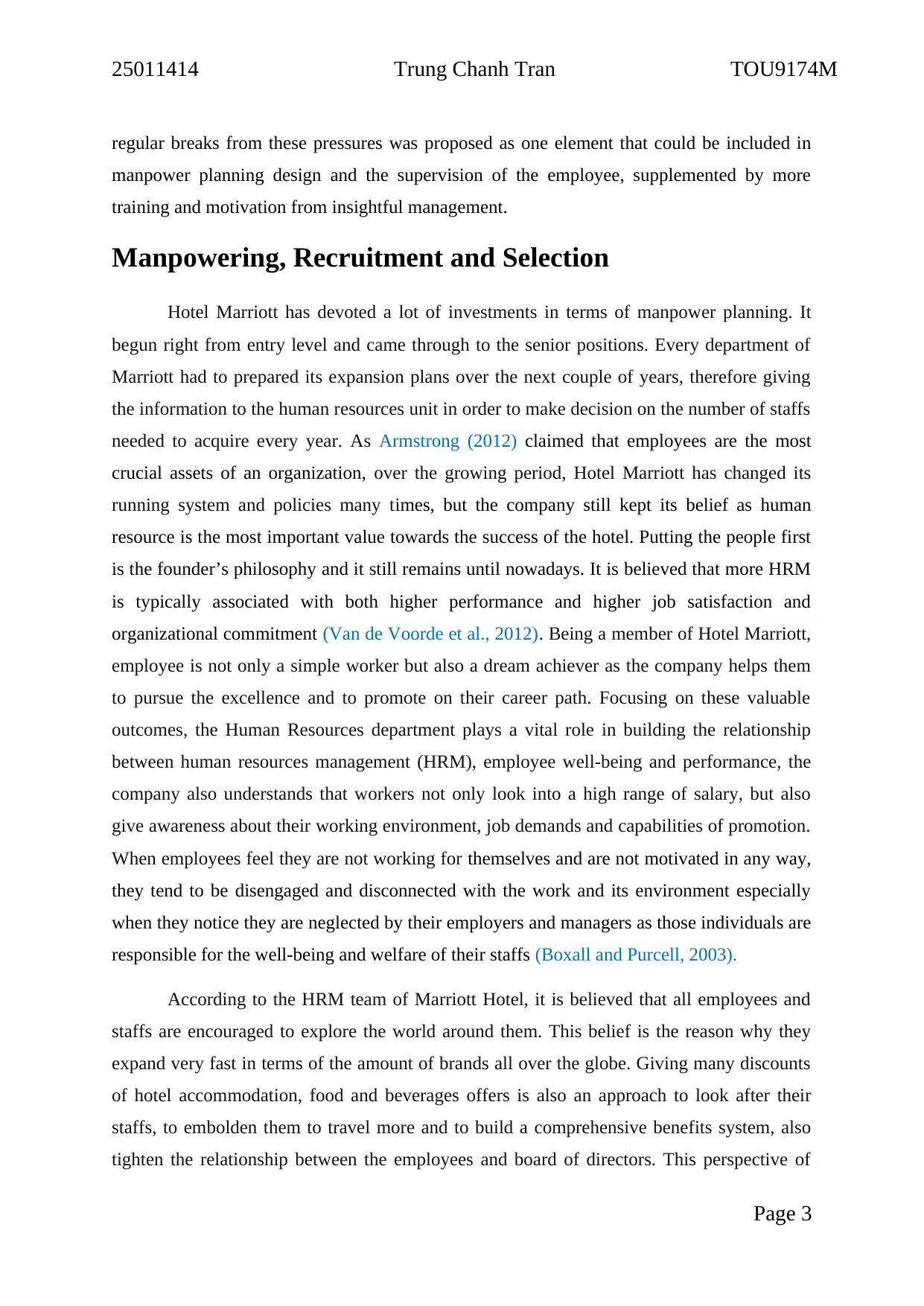
25011414 Trung Chanh Tran TOU9174M
regular breaks from these pressures was proposed as one element that could be included in
manpower planning design and the supervision of the employee, supplemented by more
training and motivation from insightful management.
Manpowering, Recruitment and Selection
Hotel Marriott has devoted a lot of investments in terms of manpower planning. It
begun right from entry level and came through to the senior positions. Every department of
Marriott had to prepared its expansion plans over the next couple of years, therefore giving
the information to the human resources unit in order to make decision on the number of staffs
needed to acquire every year. As Armstrong (2012) claimed that employees are the most
crucial assets of an organization, over the growing period, Hotel Marriott has changed its
running system and policies many times, but the company still kept its belief as human
resource is the most important value towards the success of the hotel. Putting the people first
is the founder’s philosophy and it still remains until nowadays. It is believed that more HRM
is typically associated with both higher performance and higher job satisfaction and
organizational commitment (Van de Voorde et al., 2012). Being a member of Hotel Marriott,
employee is not only a simple worker but also a dream achiever as the company helps them
to pursue the excellence and to promote on their career path. Focusing on these valuable
outcomes, the Human Resources department plays a vital role in building the relationship
between human resources management (HRM), employee well-being and performance, the
company also understands that workers not only look into a high range of salary, but also
give awareness about their working environment, job demands and capabilities of promotion.
When employees feel they are not working for themselves and are not motivated in any way,
they tend to be disengaged and disconnected with the work and its environment especially
when they notice they are neglected by their employers and managers as those individuals are
responsible for the well-being and welfare of their staffs (Boxall and Purcell, 2003).
According to the HRM team of Marriott Hotel, it is believed that all employees and
staffs are encouraged to explore the world around them. This belief is the reason why they
expand very fast in terms of the amount of brands all over the globe. Giving many discounts
of hotel accommodation, food and beverages offers is also an approach to look after their
staffs, to embolden them to travel more and to build a comprehensive benefits system, also
tighten the relationship between the employees and board of directors. This perspective of
Page 3
regular breaks from these pressures was proposed as one element that could be included in
manpower planning design and the supervision of the employee, supplemented by more
training and motivation from insightful management.
Manpowering, Recruitment and Selection
Hotel Marriott has devoted a lot of investments in terms of manpower planning. It
begun right from entry level and came through to the senior positions. Every department of
Marriott had to prepared its expansion plans over the next couple of years, therefore giving
the information to the human resources unit in order to make decision on the number of staffs
needed to acquire every year. As Armstrong (2012) claimed that employees are the most
crucial assets of an organization, over the growing period, Hotel Marriott has changed its
running system and policies many times, but the company still kept its belief as human
resource is the most important value towards the success of the hotel. Putting the people first
is the founder’s philosophy and it still remains until nowadays. It is believed that more HRM
is typically associated with both higher performance and higher job satisfaction and
organizational commitment (Van de Voorde et al., 2012). Being a member of Hotel Marriott,
employee is not only a simple worker but also a dream achiever as the company helps them
to pursue the excellence and to promote on their career path. Focusing on these valuable
outcomes, the Human Resources department plays a vital role in building the relationship
between human resources management (HRM), employee well-being and performance, the
company also understands that workers not only look into a high range of salary, but also
give awareness about their working environment, job demands and capabilities of promotion.
When employees feel they are not working for themselves and are not motivated in any way,
they tend to be disengaged and disconnected with the work and its environment especially
when they notice they are neglected by their employers and managers as those individuals are
responsible for the well-being and welfare of their staffs (Boxall and Purcell, 2003).
According to the HRM team of Marriott Hotel, it is believed that all employees and
staffs are encouraged to explore the world around them. This belief is the reason why they
expand very fast in terms of the amount of brands all over the globe. Giving many discounts
of hotel accommodation, food and beverages offers is also an approach to look after their
staffs, to embolden them to travel more and to build a comprehensive benefits system, also
tighten the relationship between the employees and board of directors. This perspective of
Page 3
Paraphrase This Document
Need a fresh take? Get an instant paraphrase of this document with our AI Paraphraser
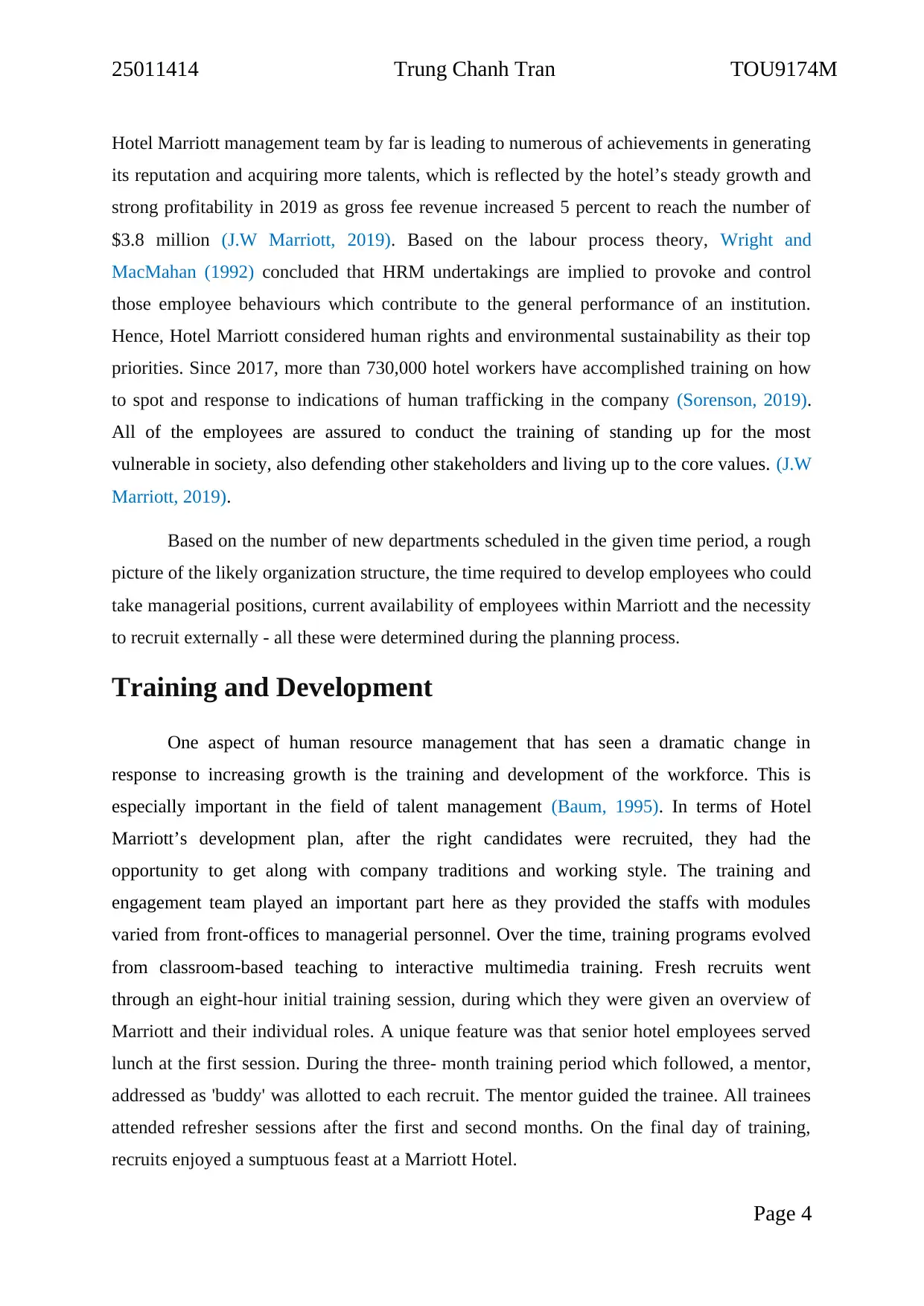
25011414 Trung Chanh Tran TOU9174M
Hotel Marriott management team by far is leading to numerous of achievements in generating
its reputation and acquiring more talents, which is reflected by the hotel’s steady growth and
strong profitability in 2019 as gross fee revenue increased 5 percent to reach the number of
$3.8 million (J.W Marriott, 2019). Based on the labour process theory, Wright and
MacMahan (1992) concluded that HRM undertakings are implied to provoke and control
those employee behaviours which contribute to the general performance of an institution.
Hence, Hotel Marriott considered human rights and environmental sustainability as their top
priorities. Since 2017, more than 730,000 hotel workers have accomplished training on how
to spot and response to indications of human trafficking in the company (Sorenson, 2019).
All of the employees are assured to conduct the training of standing up for the most
vulnerable in society, also defending other stakeholders and living up to the core values. (J.W
Marriott, 2019).
Based on the number of new departments scheduled in the given time period, a rough
picture of the likely organization structure, the time required to develop employees who could
take managerial positions, current availability of employees within Marriott and the necessity
to recruit externally - all these were determined during the planning process.
Training and Development
One aspect of human resource management that has seen a dramatic change in
response to increasing growth is the training and development of the workforce. This is
especially important in the field of talent management (Baum, 1995). In terms of Hotel
Marriott’s development plan, after the right candidates were recruited, they had the
opportunity to get along with company traditions and working style. The training and
engagement team played an important part here as they provided the staffs with modules
varied from front-offices to managerial personnel. Over the time, training programs evolved
from classroom-based teaching to interactive multimedia training. Fresh recruits went
through an eight-hour initial training session, during which they were given an overview of
Marriott and their individual roles. A unique feature was that senior hotel employees served
lunch at the first session. During the three- month training period which followed, a mentor,
addressed as 'buddy' was allotted to each recruit. The mentor guided the trainee. All trainees
attended refresher sessions after the first and second months. On the final day of training,
recruits enjoyed a sumptuous feast at a Marriott Hotel.
Page 4
Hotel Marriott management team by far is leading to numerous of achievements in generating
its reputation and acquiring more talents, which is reflected by the hotel’s steady growth and
strong profitability in 2019 as gross fee revenue increased 5 percent to reach the number of
$3.8 million (J.W Marriott, 2019). Based on the labour process theory, Wright and
MacMahan (1992) concluded that HRM undertakings are implied to provoke and control
those employee behaviours which contribute to the general performance of an institution.
Hence, Hotel Marriott considered human rights and environmental sustainability as their top
priorities. Since 2017, more than 730,000 hotel workers have accomplished training on how
to spot and response to indications of human trafficking in the company (Sorenson, 2019).
All of the employees are assured to conduct the training of standing up for the most
vulnerable in society, also defending other stakeholders and living up to the core values. (J.W
Marriott, 2019).
Based on the number of new departments scheduled in the given time period, a rough
picture of the likely organization structure, the time required to develop employees who could
take managerial positions, current availability of employees within Marriott and the necessity
to recruit externally - all these were determined during the planning process.
Training and Development
One aspect of human resource management that has seen a dramatic change in
response to increasing growth is the training and development of the workforce. This is
especially important in the field of talent management (Baum, 1995). In terms of Hotel
Marriott’s development plan, after the right candidates were recruited, they had the
opportunity to get along with company traditions and working style. The training and
engagement team played an important part here as they provided the staffs with modules
varied from front-offices to managerial personnel. Over the time, training programs evolved
from classroom-based teaching to interactive multimedia training. Fresh recruits went
through an eight-hour initial training session, during which they were given an overview of
Marriott and their individual roles. A unique feature was that senior hotel employees served
lunch at the first session. During the three- month training period which followed, a mentor,
addressed as 'buddy' was allotted to each recruit. The mentor guided the trainee. All trainees
attended refresher sessions after the first and second months. On the final day of training,
recruits enjoyed a sumptuous feast at a Marriott Hotel.
Page 4
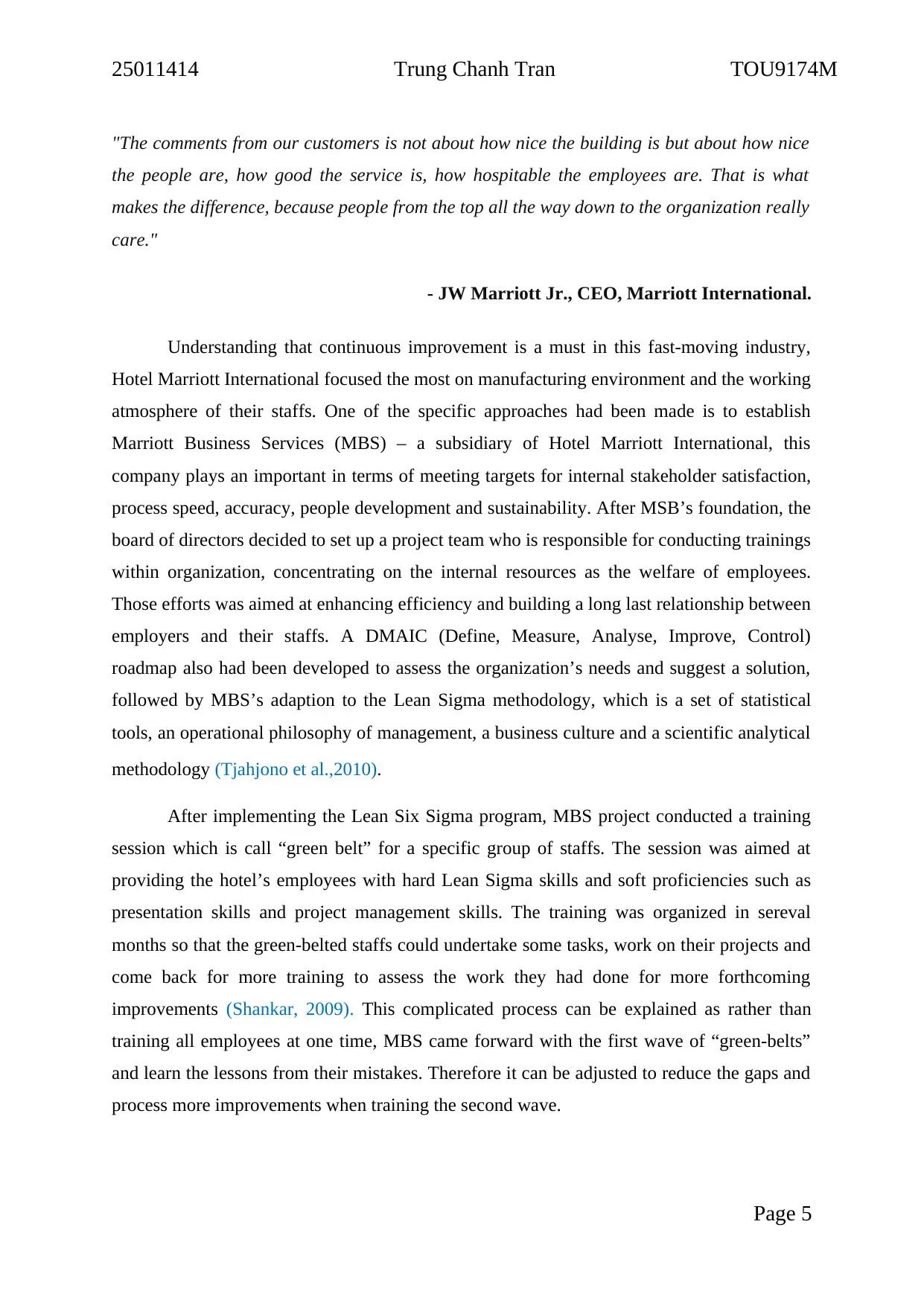
25011414 Trung Chanh Tran TOU9174M
"The comments from our customers is not about how nice the building is but about how nice
the people are, how good the service is, how hospitable the employees are. That is what
makes the difference, because people from the top all the way down to the organization really
care."
- JW Marriott Jr., CEO, Marriott International.
Understanding that continuous improvement is a must in this fast-moving industry,
Hotel Marriott International focused the most on manufacturing environment and the working
atmosphere of their staffs. One of the specific approaches had been made is to establish
Marriott Business Services (MBS) – a subsidiary of Hotel Marriott International, this
company plays an important in terms of meeting targets for internal stakeholder satisfaction,
process speed, accuracy, people development and sustainability. After MSB’s foundation, the
board of directors decided to set up a project team who is responsible for conducting trainings
within organization, concentrating on the internal resources as the welfare of employees.
Those efforts was aimed at enhancing efficiency and building a long last relationship between
employers and their staffs. A DMAIC (Define, Measure, Analyse, Improve, Control)
roadmap also had been developed to assess the organization’s needs and suggest a solution,
followed by MBS’s adaption to the Lean Sigma methodology, which is a set of statistical
tools, an operational philosophy of management, a business culture and a scientific analytical
methodology (Tjahjono et al.,2010).
After implementing the Lean Six Sigma program, MBS project conducted a training
session which is call “green belt” for a specific group of staffs. The session was aimed at
providing the hotel’s employees with hard Lean Sigma skills and soft proficiencies such as
presentation skills and project management skills. The training was organized in sereval
months so that the green-belted staffs could undertake some tasks, work on their projects and
come back for more training to assess the work they had done for more forthcoming
improvements (Shankar, 2009). This complicated process can be explained as rather than
training all employees at one time, MBS came forward with the first wave of “green-belts”
and learn the lessons from their mistakes. Therefore it can be adjusted to reduce the gaps and
process more improvements when training the second wave.
Page 5
"The comments from our customers is not about how nice the building is but about how nice
the people are, how good the service is, how hospitable the employees are. That is what
makes the difference, because people from the top all the way down to the organization really
care."
- JW Marriott Jr., CEO, Marriott International.
Understanding that continuous improvement is a must in this fast-moving industry,
Hotel Marriott International focused the most on manufacturing environment and the working
atmosphere of their staffs. One of the specific approaches had been made is to establish
Marriott Business Services (MBS) – a subsidiary of Hotel Marriott International, this
company plays an important in terms of meeting targets for internal stakeholder satisfaction,
process speed, accuracy, people development and sustainability. After MSB’s foundation, the
board of directors decided to set up a project team who is responsible for conducting trainings
within organization, concentrating on the internal resources as the welfare of employees.
Those efforts was aimed at enhancing efficiency and building a long last relationship between
employers and their staffs. A DMAIC (Define, Measure, Analyse, Improve, Control)
roadmap also had been developed to assess the organization’s needs and suggest a solution,
followed by MBS’s adaption to the Lean Sigma methodology, which is a set of statistical
tools, an operational philosophy of management, a business culture and a scientific analytical
methodology (Tjahjono et al.,2010).
After implementing the Lean Six Sigma program, MBS project conducted a training
session which is call “green belt” for a specific group of staffs. The session was aimed at
providing the hotel’s employees with hard Lean Sigma skills and soft proficiencies such as
presentation skills and project management skills. The training was organized in sereval
months so that the green-belted staffs could undertake some tasks, work on their projects and
come back for more training to assess the work they had done for more forthcoming
improvements (Shankar, 2009). This complicated process can be explained as rather than
training all employees at one time, MBS came forward with the first wave of “green-belts”
and learn the lessons from their mistakes. Therefore it can be adjusted to reduce the gaps and
process more improvements when training the second wave.
Page 5
⊘ This is a preview!⊘
Do you want full access?
Subscribe today to unlock all pages.

Trusted by 1+ million students worldwide
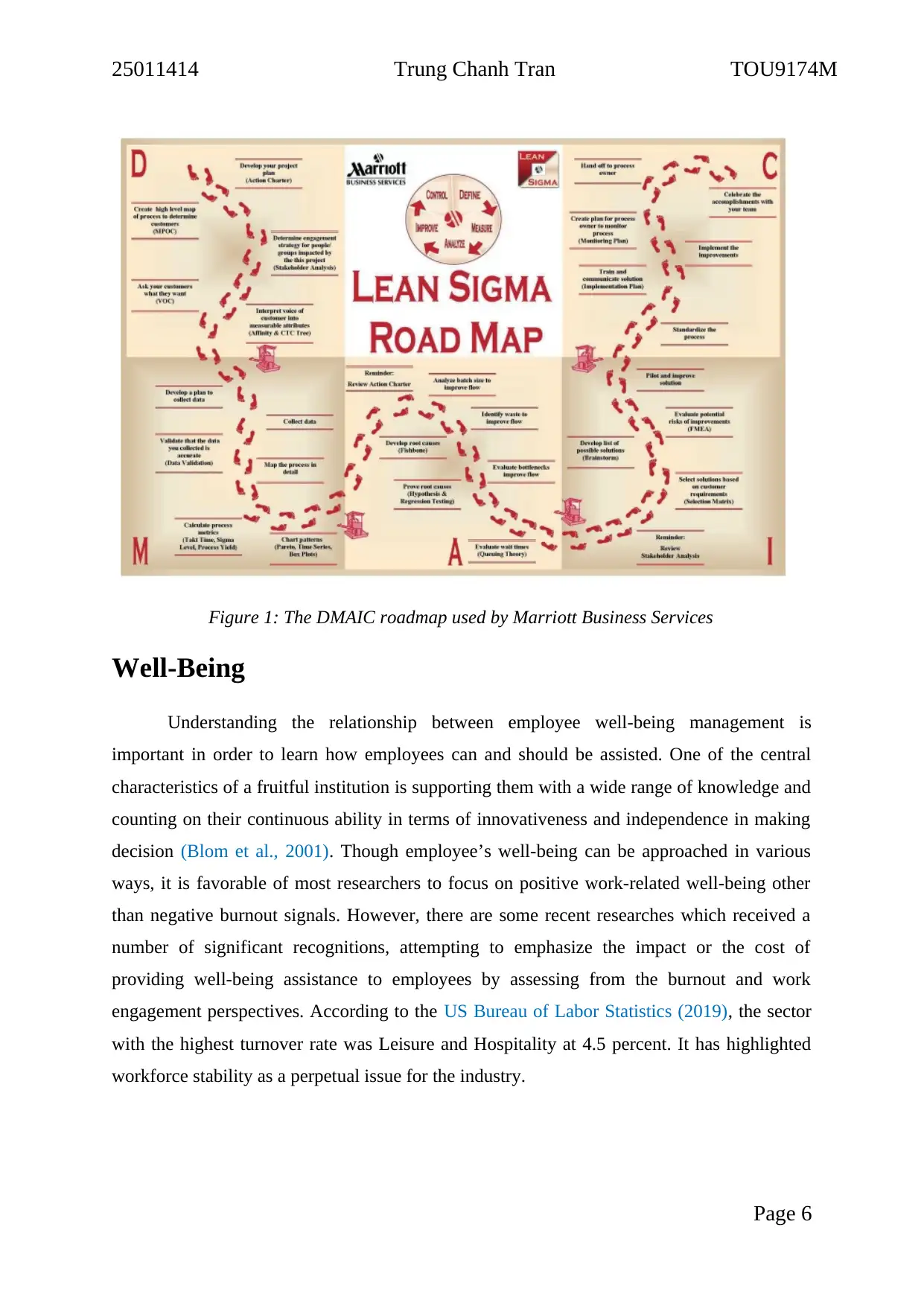
25011414 Trung Chanh Tran TOU9174M
Figure 1: The DMAIC roadmap used by Marriott Business Services
Well-Being
Understanding the relationship between employee well-being management is
important in order to learn how employees can and should be assisted. One of the central
characteristics of a fruitful institution is supporting them with a wide range of knowledge and
counting on their continuous ability in terms of innovativeness and independence in making
decision (Blom et al., 2001). Though employee’s well-being can be approached in various
ways, it is favorable of most researchers to focus on positive work-related well-being other
than negative burnout signals. However, there are some recent researches which received a
number of significant recognitions, attempting to emphasize the impact or the cost of
providing well-being assistance to employees by assessing from the burnout and work
engagement perspectives. According to the US Bureau of Labor Statistics (2019), the sector
with the highest turnover rate was Leisure and Hospitality at 4.5 percent. It has highlighted
workforce stability as a perpetual issue for the industry.
Page 6
Figure 1: The DMAIC roadmap used by Marriott Business Services
Well-Being
Understanding the relationship between employee well-being management is
important in order to learn how employees can and should be assisted. One of the central
characteristics of a fruitful institution is supporting them with a wide range of knowledge and
counting on their continuous ability in terms of innovativeness and independence in making
decision (Blom et al., 2001). Though employee’s well-being can be approached in various
ways, it is favorable of most researchers to focus on positive work-related well-being other
than negative burnout signals. However, there are some recent researches which received a
number of significant recognitions, attempting to emphasize the impact or the cost of
providing well-being assistance to employees by assessing from the burnout and work
engagement perspectives. According to the US Bureau of Labor Statistics (2019), the sector
with the highest turnover rate was Leisure and Hospitality at 4.5 percent. It has highlighted
workforce stability as a perpetual issue for the industry.
Page 6
Paraphrase This Document
Need a fresh take? Get an instant paraphrase of this document with our AI Paraphraser
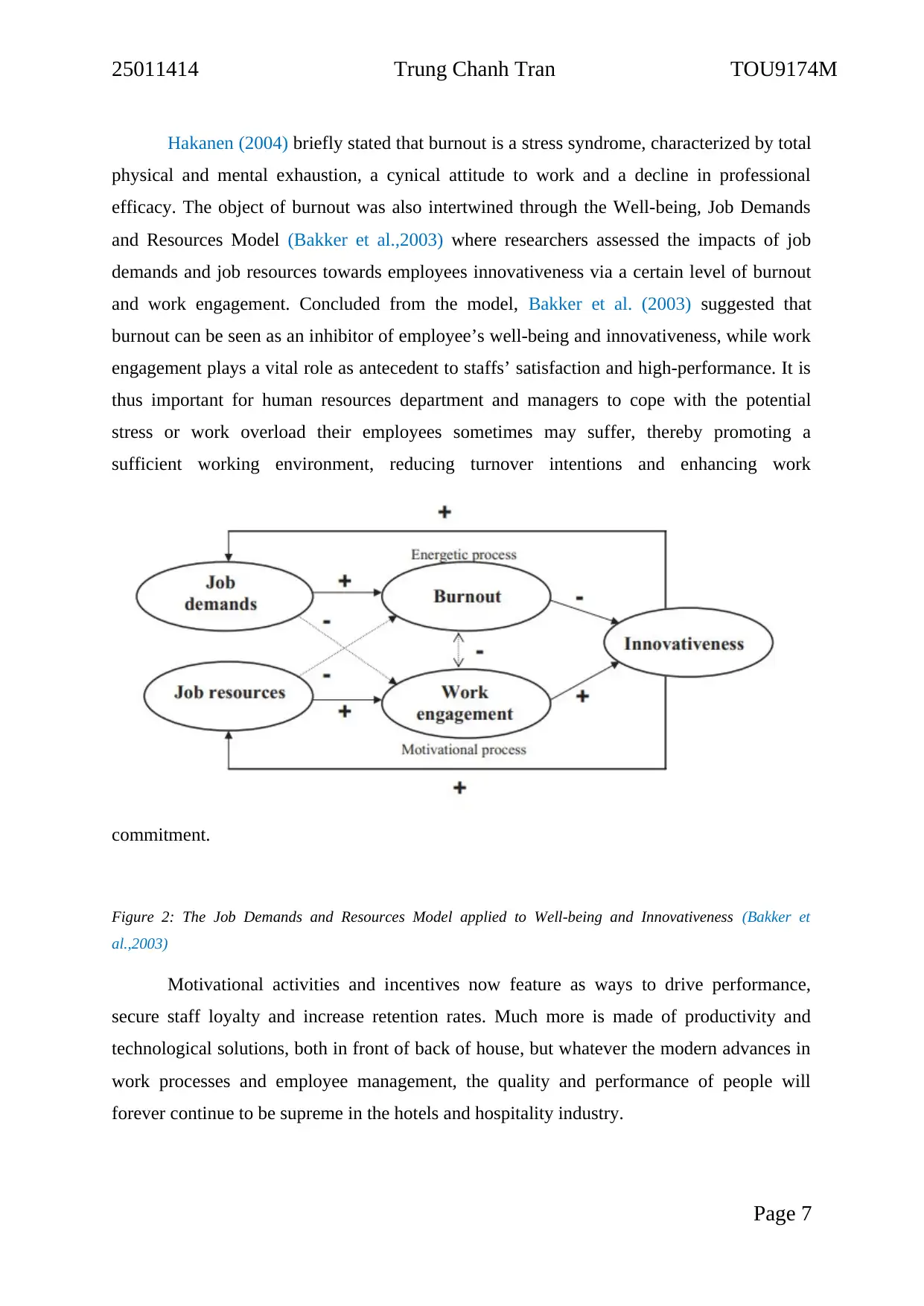
25011414 Trung Chanh Tran TOU9174M
Hakanen (2004) briefly stated that burnout is a stress syndrome, characterized by total
physical and mental exhaustion, a cynical attitude to work and a decline in professional
efficacy. The object of burnout was also intertwined through the Well-being, Job Demands
and Resources Model (Bakker et al.,2003) where researchers assessed the impacts of job
demands and job resources towards employees innovativeness via a certain level of burnout
and work engagement. Concluded from the model, Bakker et al. (2003) suggested that
burnout can be seen as an inhibitor of employee’s well-being and innovativeness, while work
engagement plays a vital role as antecedent to staffs’ satisfaction and high-performance. It is
thus important for human resources department and managers to cope with the potential
stress or work overload their employees sometimes may suffer, thereby promoting a
sufficient working environment, reducing turnover intentions and enhancing work
commitment.
Figure 2: The Job Demands and Resources Model applied to Well-being and Innovativeness (Bakker et
al.,2003)
Motivational activities and incentives now feature as ways to drive performance,
secure staff loyalty and increase retention rates. Much more is made of productivity and
technological solutions, both in front of back of house, but whatever the modern advances in
work processes and employee management, the quality and performance of people will
forever continue to be supreme in the hotels and hospitality industry.
Page 7
Hakanen (2004) briefly stated that burnout is a stress syndrome, characterized by total
physical and mental exhaustion, a cynical attitude to work and a decline in professional
efficacy. The object of burnout was also intertwined through the Well-being, Job Demands
and Resources Model (Bakker et al.,2003) where researchers assessed the impacts of job
demands and job resources towards employees innovativeness via a certain level of burnout
and work engagement. Concluded from the model, Bakker et al. (2003) suggested that
burnout can be seen as an inhibitor of employee’s well-being and innovativeness, while work
engagement plays a vital role as antecedent to staffs’ satisfaction and high-performance. It is
thus important for human resources department and managers to cope with the potential
stress or work overload their employees sometimes may suffer, thereby promoting a
sufficient working environment, reducing turnover intentions and enhancing work
commitment.
Figure 2: The Job Demands and Resources Model applied to Well-being and Innovativeness (Bakker et
al.,2003)
Motivational activities and incentives now feature as ways to drive performance,
secure staff loyalty and increase retention rates. Much more is made of productivity and
technological solutions, both in front of back of house, but whatever the modern advances in
work processes and employee management, the quality and performance of people will
forever continue to be supreme in the hotels and hospitality industry.
Page 7
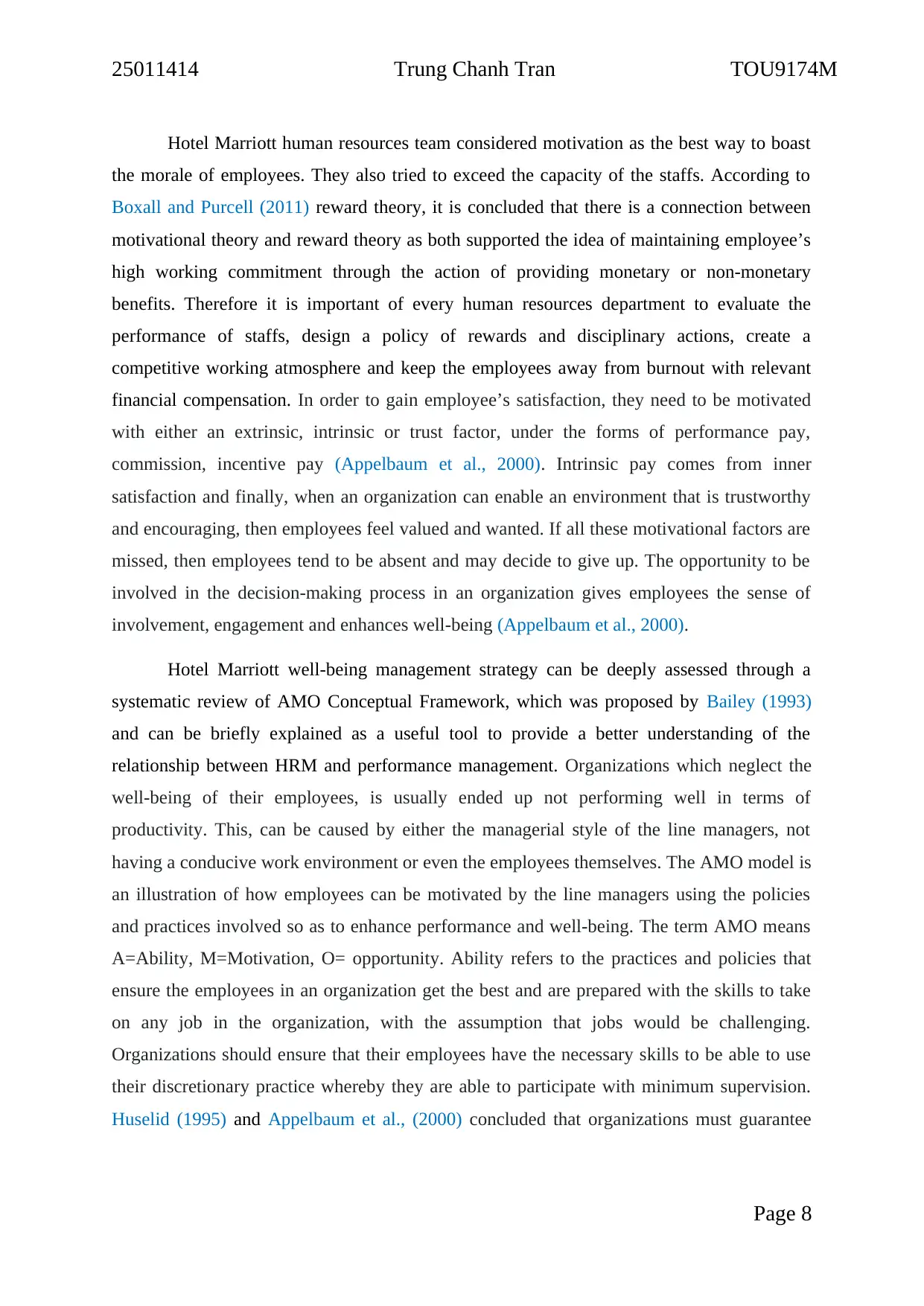
25011414 Trung Chanh Tran TOU9174M
Hotel Marriott human resources team considered motivation as the best way to boast
the morale of employees. They also tried to exceed the capacity of the staffs. According to
Boxall and Purcell (2011) reward theory, it is concluded that there is a connection between
motivational theory and reward theory as both supported the idea of maintaining employee’s
high working commitment through the action of providing monetary or non-monetary
benefits. Therefore it is important of every human resources department to evaluate the
performance of staffs, design a policy of rewards and disciplinary actions, create a
competitive working atmosphere and keep the employees away from burnout with relevant
financial compensation. In order to gain employee’s satisfaction, they need to be motivated
with either an extrinsic, intrinsic or trust factor, under the forms of performance pay,
commission, incentive pay (Appelbaum et al., 2000). Intrinsic pay comes from inner
satisfaction and finally, when an organization can enable an environment that is trustworthy
and encouraging, then employees feel valued and wanted. If all these motivational factors are
missed, then employees tend to be absent and may decide to give up. The opportunity to be
involved in the decision-making process in an organization gives employees the sense of
involvement, engagement and enhances well-being (Appelbaum et al., 2000).
Hotel Marriott well-being management strategy can be deeply assessed through a
systematic review of AMO Conceptual Framework, which was proposed by Bailey (1993)
and can be briefly explained as a useful tool to provide a better understanding of the
relationship between HRM and performance management. Organizations which neglect the
well-being of their employees, is usually ended up not performing well in terms of
productivity. This, can be caused by either the managerial style of the line managers, not
having a conducive work environment or even the employees themselves. The AMO model is
an illustration of how employees can be motivated by the line managers using the policies
and practices involved so as to enhance performance and well-being. The term AMO means
A=Ability, M=Motivation, O= opportunity. Ability refers to the practices and policies that
ensure the employees in an organization get the best and are prepared with the skills to take
on any job in the organization, with the assumption that jobs would be challenging.
Organizations should ensure that their employees have the necessary skills to be able to use
their discretionary practice whereby they are able to participate with minimum supervision.
Huselid (1995) and Appelbaum et al., (2000) concluded that organizations must guarantee
Page 8
Hotel Marriott human resources team considered motivation as the best way to boast
the morale of employees. They also tried to exceed the capacity of the staffs. According to
Boxall and Purcell (2011) reward theory, it is concluded that there is a connection between
motivational theory and reward theory as both supported the idea of maintaining employee’s
high working commitment through the action of providing monetary or non-monetary
benefits. Therefore it is important of every human resources department to evaluate the
performance of staffs, design a policy of rewards and disciplinary actions, create a
competitive working atmosphere and keep the employees away from burnout with relevant
financial compensation. In order to gain employee’s satisfaction, they need to be motivated
with either an extrinsic, intrinsic or trust factor, under the forms of performance pay,
commission, incentive pay (Appelbaum et al., 2000). Intrinsic pay comes from inner
satisfaction and finally, when an organization can enable an environment that is trustworthy
and encouraging, then employees feel valued and wanted. If all these motivational factors are
missed, then employees tend to be absent and may decide to give up. The opportunity to be
involved in the decision-making process in an organization gives employees the sense of
involvement, engagement and enhances well-being (Appelbaum et al., 2000).
Hotel Marriott well-being management strategy can be deeply assessed through a
systematic review of AMO Conceptual Framework, which was proposed by Bailey (1993)
and can be briefly explained as a useful tool to provide a better understanding of the
relationship between HRM and performance management. Organizations which neglect the
well-being of their employees, is usually ended up not performing well in terms of
productivity. This, can be caused by either the managerial style of the line managers, not
having a conducive work environment or even the employees themselves. The AMO model is
an illustration of how employees can be motivated by the line managers using the policies
and practices involved so as to enhance performance and well-being. The term AMO means
A=Ability, M=Motivation, O= opportunity. Ability refers to the practices and policies that
ensure the employees in an organization get the best and are prepared with the skills to take
on any job in the organization, with the assumption that jobs would be challenging.
Organizations should ensure that their employees have the necessary skills to be able to use
their discretionary practice whereby they are able to participate with minimum supervision.
Huselid (1995) and Appelbaum et al., (2000) concluded that organizations must guarantee
Page 8
⊘ This is a preview!⊘
Do you want full access?
Subscribe today to unlock all pages.

Trusted by 1+ million students worldwide
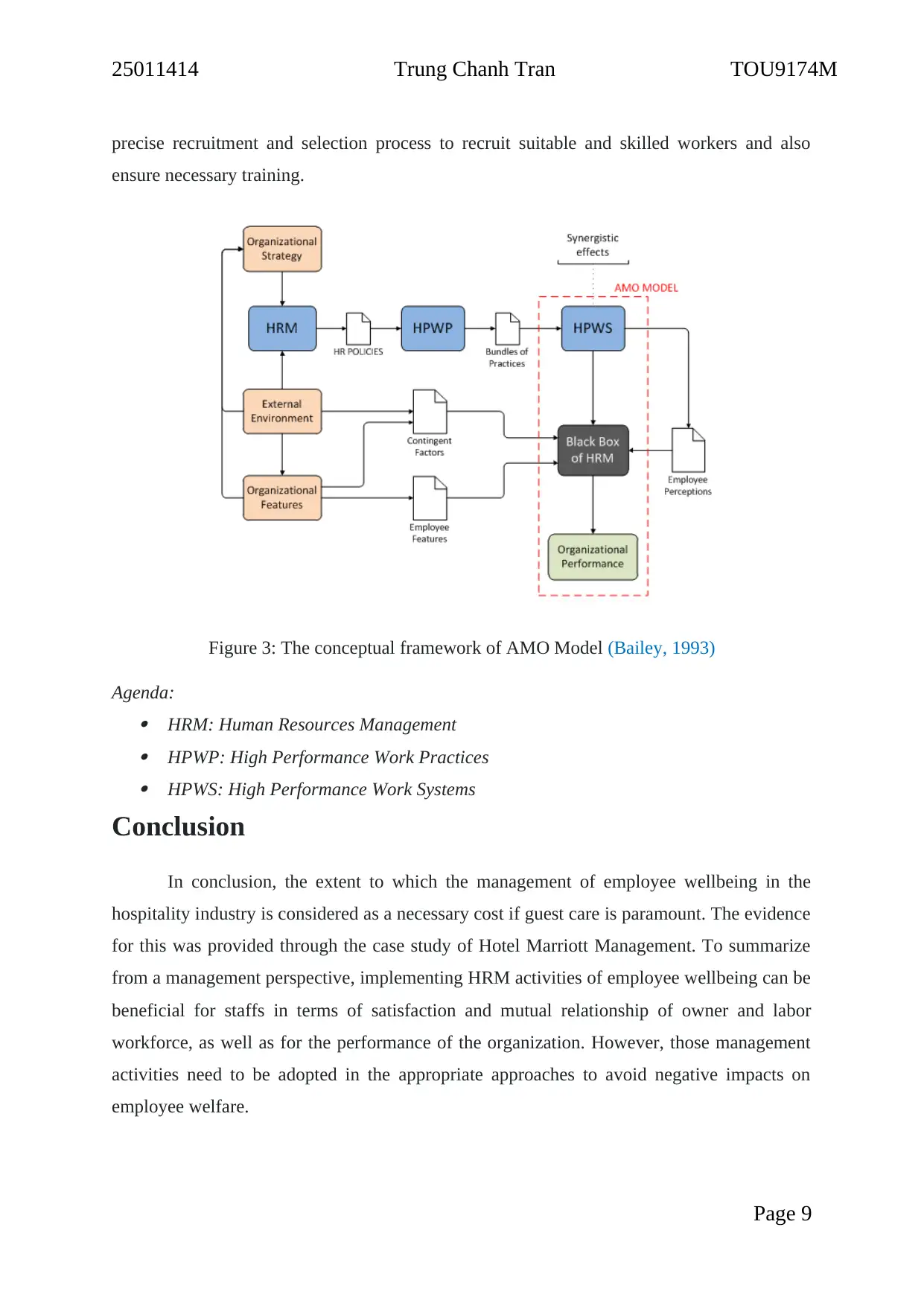
25011414 Trung Chanh Tran TOU9174M
precise recruitment and selection process to recruit suitable and skilled workers and also
ensure necessary training.
Figure 3: The conceptual framework of AMO Model (Bailey, 1993)
Agenda: HRM: Human Resources Management HPWP: High Performance Work Practices HPWS: High Performance Work Systems
Conclusion
In conclusion, the extent to which the management of employee wellbeing in the
hospitality industry is considered as a necessary cost if guest care is paramount. The evidence
for this was provided through the case study of Hotel Marriott Management. To summarize
from a management perspective, implementing HRM activities of employee wellbeing can be
beneficial for staffs in terms of satisfaction and mutual relationship of owner and labor
workforce, as well as for the performance of the organization. However, those management
activities need to be adopted in the appropriate approaches to avoid negative impacts on
employee welfare.
Page 9
precise recruitment and selection process to recruit suitable and skilled workers and also
ensure necessary training.
Figure 3: The conceptual framework of AMO Model (Bailey, 1993)
Agenda: HRM: Human Resources Management HPWP: High Performance Work Practices HPWS: High Performance Work Systems
Conclusion
In conclusion, the extent to which the management of employee wellbeing in the
hospitality industry is considered as a necessary cost if guest care is paramount. The evidence
for this was provided through the case study of Hotel Marriott Management. To summarize
from a management perspective, implementing HRM activities of employee wellbeing can be
beneficial for staffs in terms of satisfaction and mutual relationship of owner and labor
workforce, as well as for the performance of the organization. However, those management
activities need to be adopted in the appropriate approaches to avoid negative impacts on
employee welfare.
Page 9
Paraphrase This Document
Need a fresh take? Get an instant paraphrase of this document with our AI Paraphraser
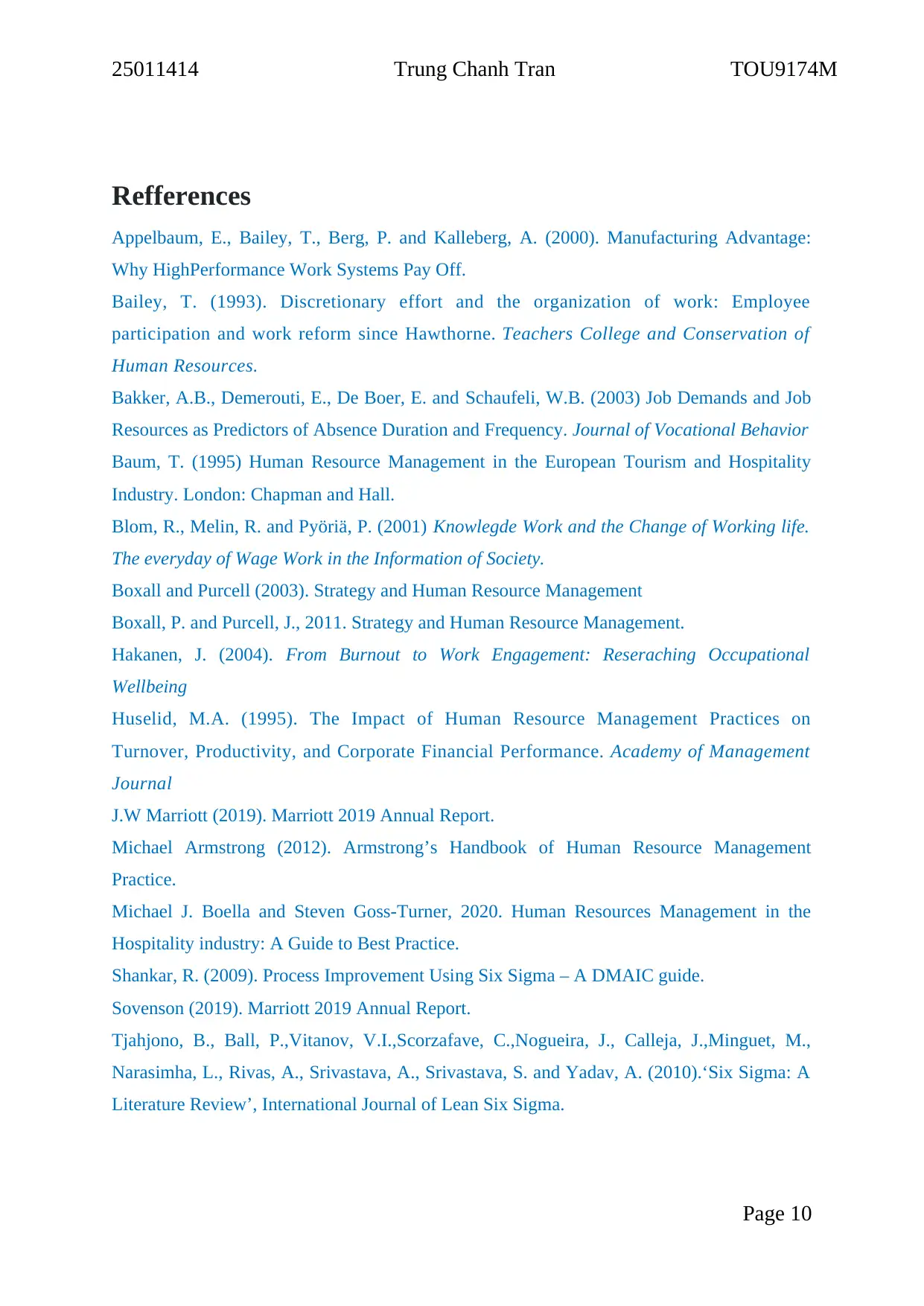
25011414 Trung Chanh Tran TOU9174M
Refferences
Appelbaum, E., Bailey, T., Berg, P. and Kalleberg, A. (2000). Manufacturing Advantage:
Why HighPerformance Work Systems Pay Off.
Bailey, T. (1993). Discretionary effort and the organization of work: Employee
participation and work reform since Hawthorne. Teachers College and Conservation of
Human Resources.
Bakker, A.B., Demerouti, E., De Boer, E. and Schaufeli, W.B. (2003) Job Demands and Job
Resources as Predictors of Absence Duration and Frequency. Journal of Vocational Behavior
Baum, T. (1995) Human Resource Management in the European Tourism and Hospitality
Industry. London: Chapman and Hall.
Blom, R., Melin, R. and Pyöriä, P. (2001) Knowlegde Work and the Change of Working life.
The everyday of Wage Work in the Information of Society.
Boxall and Purcell (2003). Strategy and Human Resource Management
Boxall, P. and Purcell, J., 2011. Strategy and Human Resource Management.
Hakanen, J. (2004). From Burnout to Work Engagement: Reseraching Occupational
Wellbeing
Huselid, M.A. (1995). The Impact of Human Resource Management Practices on
Turnover, Productivity, and Corporate Financial Performance. Academy of Management
Journal
J.W Marriott (2019). Marriott 2019 Annual Report.
Michael Armstrong (2012). Armstrong’s Handbook of Human Resource Management
Practice.
Michael J. Boella and Steven Goss-Turner, 2020. Human Resources Management in the
Hospitality industry: A Guide to Best Practice.
Shankar, R. (2009). Process Improvement Using Six Sigma – A DMAIC guide.
Sovenson (2019). Marriott 2019 Annual Report.
Tjahjono, B., Ball, P.,Vitanov, V.I.,Scorzafave, C.,Nogueira, J., Calleja, J.,Minguet, M.,
Narasimha, L., Rivas, A., Srivastava, A., Srivastava, S. and Yadav, A. (2010).‘Six Sigma: A
Literature Review’, International Journal of Lean Six Sigma.
Page 10
Refferences
Appelbaum, E., Bailey, T., Berg, P. and Kalleberg, A. (2000). Manufacturing Advantage:
Why HighPerformance Work Systems Pay Off.
Bailey, T. (1993). Discretionary effort and the organization of work: Employee
participation and work reform since Hawthorne. Teachers College and Conservation of
Human Resources.
Bakker, A.B., Demerouti, E., De Boer, E. and Schaufeli, W.B. (2003) Job Demands and Job
Resources as Predictors of Absence Duration and Frequency. Journal of Vocational Behavior
Baum, T. (1995) Human Resource Management in the European Tourism and Hospitality
Industry. London: Chapman and Hall.
Blom, R., Melin, R. and Pyöriä, P. (2001) Knowlegde Work and the Change of Working life.
The everyday of Wage Work in the Information of Society.
Boxall and Purcell (2003). Strategy and Human Resource Management
Boxall, P. and Purcell, J., 2011. Strategy and Human Resource Management.
Hakanen, J. (2004). From Burnout to Work Engagement: Reseraching Occupational
Wellbeing
Huselid, M.A. (1995). The Impact of Human Resource Management Practices on
Turnover, Productivity, and Corporate Financial Performance. Academy of Management
Journal
J.W Marriott (2019). Marriott 2019 Annual Report.
Michael Armstrong (2012). Armstrong’s Handbook of Human Resource Management
Practice.
Michael J. Boella and Steven Goss-Turner, 2020. Human Resources Management in the
Hospitality industry: A Guide to Best Practice.
Shankar, R. (2009). Process Improvement Using Six Sigma – A DMAIC guide.
Sovenson (2019). Marriott 2019 Annual Report.
Tjahjono, B., Ball, P.,Vitanov, V.I.,Scorzafave, C.,Nogueira, J., Calleja, J.,Minguet, M.,
Narasimha, L., Rivas, A., Srivastava, A., Srivastava, S. and Yadav, A. (2010).‘Six Sigma: A
Literature Review’, International Journal of Lean Six Sigma.
Page 10
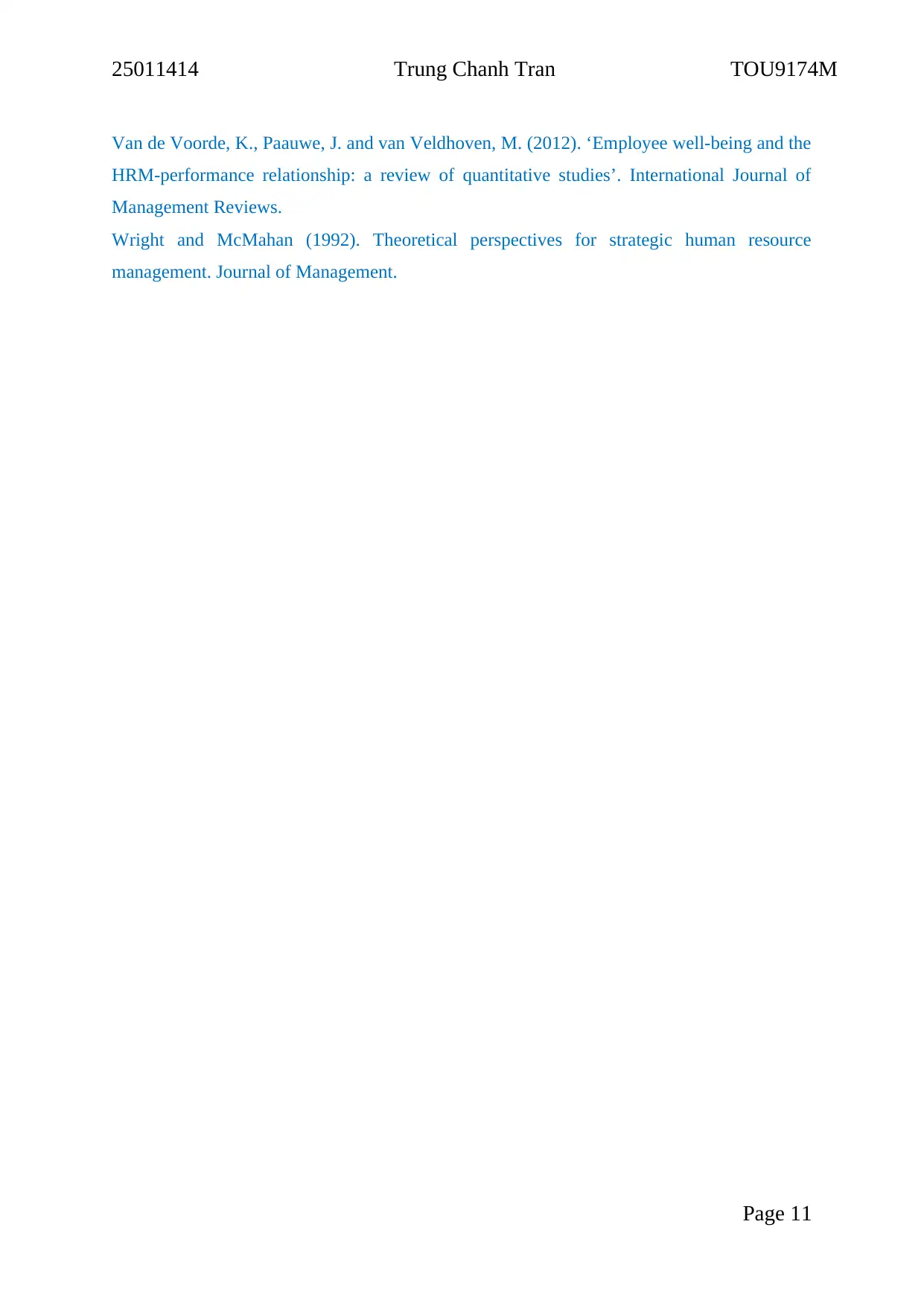
25011414 Trung Chanh Tran TOU9174M
Van de Voorde, K., Paauwe, J. and van Veldhoven, M. (2012). ‘Employee well-being and the
HRM-performance relationship: a review of quantitative studies’. International Journal of
Management Reviews.
Wright and McMahan (1992). Theoretical perspectives for strategic human resource
management. Journal of Management.
Page 11
Van de Voorde, K., Paauwe, J. and van Veldhoven, M. (2012). ‘Employee well-being and the
HRM-performance relationship: a review of quantitative studies’. International Journal of
Management Reviews.
Wright and McMahan (1992). Theoretical perspectives for strategic human resource
management. Journal of Management.
Page 11
⊘ This is a preview!⊘
Do you want full access?
Subscribe today to unlock all pages.

Trusted by 1+ million students worldwide
1 out of 12
Related Documents
Your All-in-One AI-Powered Toolkit for Academic Success.
+13062052269
info@desklib.com
Available 24*7 on WhatsApp / Email
![[object Object]](/_next/static/media/star-bottom.7253800d.svg)
Unlock your academic potential
Copyright © 2020–2025 A2Z Services. All Rights Reserved. Developed and managed by ZUCOL.




